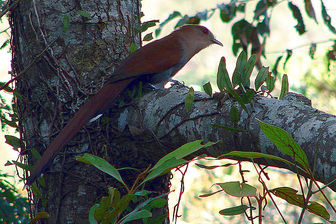Squirrel Cuckoo
This large and extremely long-tailed cuckoo is 43-46 cm long and weighs 95-105 g. The adult has mainly chestnut upperparts and head, becoming paler on the throat. The lower breast is grey and the belly is blackish. The central tail feathers are rufous, but the outer are black with white tips. The bill is yellow and the iris is red. Immature birds have a grey bill and eyering, brown iris, and less white in the tail.

Original source: self-made, Petropolis city, Rio de Janeiro
Author: Eurico Zimbres
The Squirrel Cuckoo is classified as Least Concern. Does not qualify for a more at risk category. Widespread and abundant taxa are included in this category.
The Squirrel Cuckoo, Piaya cayana, is a cuckoo species breeding from northwestern Mexico to northern Argentina and Uruguay, and on Trinidad. The contrasting undertail plumage This large and extremely long-tailed cuckoo is 43-46 cm long and weighs 95-105 g. The adult has mainly chestnut upperparts and head, becoming paler on the throat. The lower breast is grey and the belly is blackish. The central tail feathers are rufous, but the outer are black with white tips. More
The Squirrel Cuckoo is found in woodland canopy and edges, second growth, hedges and semi-open habitats from sea level to as high as 2500 m altitude, although it is uncommon above 1200 m. This species More
The Squirrel Cuckoo, Piaya cayana, is a near-passerine bird. This cuckoo is a resident breeding bird from northwestern Mexico to northern Argentina and Uruguay, and on Trinidad. The Squirrel Cuckoo is found in woodland canopy and edges, second growth, hedges and semi-open habitats from sea level to as high as 2500 m altitude, although it is uncommon above 1200 m. The nest is a cup of leaves on a twig foundation, hidden in dense vegetation 1-12 m high in a tree. More
The Squirrel Cuckoo (Piaya cayana) is a resident of a variety of forest types from northern Mexico south to Argentina and Uruguay. It is very widespread and fairly common through its range. The two shots here were taken at Chan Chich in the Orange Walk District of Belize, in December, 1999, with a Canon EOS 1N and EF 300mm F/2.8 L lens and 2X extender on Fuji Provia film. More
Squirrel Cuckoos (Piaya cayana) are found throughout Costa Rica in second growth forests, at forest edges and openings, and in open woodland areas from the lowlands to the mountains. These large cuckoos are fairly common, but they are rather widely dispersed and are often solitary or found in pairs. Squirrel Cuckoos range from Mexico down to Argentina. We spotted this lone Squirrel Cuckoo flying from tree to tree in a hotel garden in Alajuela, Costa Rica. More
America, Squirrel Cuckoos are common and do seem "squirrel-like" as they move through the canopy. Several South American cuckoos are migratory, moving to the equator in the southern winter (our summer). On of these is the Ash-colored Cuckoo C. cinereus. In July 1975, I discovered this tiny cuckoo on the banks of the Amazon River at Leticia where it proved to be a first record for Colombia. More
The Squirrel Cuckoo is plentiful in most of its range and appears to be quite tolerant of human disturbance, as long as wooded land remains. It is considered a species of Least Concern by the IUCN. More

Original source: Andy Jones
Author: Andy Jones
Permission: Some rights reserved
